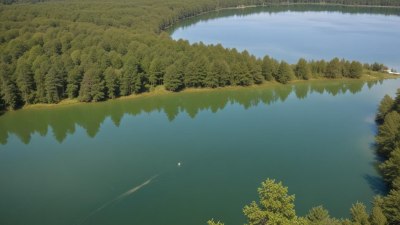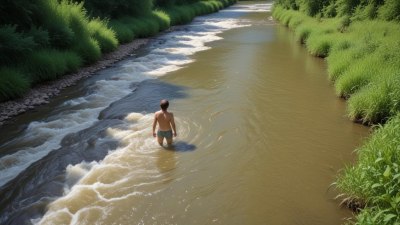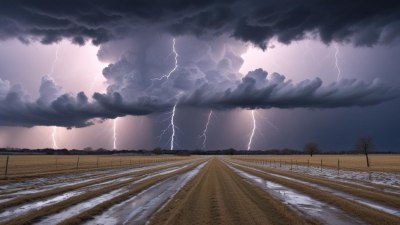Why That 'Shallow Spot' in the Lake Is Always Deeper Than Expected
Explore the unexpected depths of shallow spots in lakes, revealing aquatic insights.

This image was created with the assistance of Freepik
Have you ever walked along the shore of a lake, confidently stepping into what appears to be a shallow spot, only to find yourself unexpectedly in deeper water? This phenomenon occurs in many lakes, and it's rooted in various natural and geological factors.
To understand why these shallow spots can be misleading, it's important to investigate the topography of the lakebed. Lakes are not uniform; some have gentle slopes while others may have abrupt changes in depth.
Understanding Lake Topography
The bathymetry of a lake describes the underwater relief and variations in depth. Many lakes feature sunkissed shallows that may extend over large areas, leading to the common perception that these areas are uniformly shallow. However, irregularities in the lakebed can create deeper pockets or troughs even within these seemingly shallow areas.
For instance, geological formations such as sediment deposits, underwater currents, or even submerged structures can create deceptive appearances. Sandbars might appear to be a continuous flat area; however, there could be sudden drops just a few feet away, making them dangerous for unsuspecting swimmers.
Water Levels and Seasonal Changes
Another factor that contributes to the deceptive nature of shallow spots is fluctuating water levels. Lakes can experience variations in depth due to seasonal changes, precipitation, or even human activities such as dam releases. During dry seasons or droughts, water levels might drop, exposing sandy bottoms or rocks, which may seem shallow. However, during heavy rains or snowmelt, those same areas could suddenly become considerably deeper.
This fluctuation plays a crucial role in the habitat of aquatic life. Fish and other animals may adapt their spawning behaviors according to the changes in water levels, utilizing these shallow spots for breeding during certain periods.
Fine Sediment and Water Clarity
Moreover, the clarity of the water affects how depth is perceived. In lakes with fine sediment such as silt or mud, light refraction can mislead the eye. This phenomenon occurs because light bends when it travels through water, making objects appear closer than they are. This lensing effect can cause swimmers or waders to underestimate the actual depth of the water, leading to a rude awakening when they step into what they thought was just a few inches deep.
Additionally, the presence of periphyton—tiny aquatic organisms that cling to plants, rocks, and underwater substrates—can cloud visibility. When this occurs, even skilled swimmers can find it challenging to gauge depth accurately.
Impact of Human Activities
Human activities can also contribute to unexpected depth in seemingly shallow spots. Activities such as dredging, construction, or the introduction of artificial structures can alter the landscape of a lakebed, creating unexpected slopes and sudden depth increases. Dredging, in particular, is often performed to maintain waterways or improve boat access but can lead to inconsistencies that affect how shallow areas are perceived.
Moreover, debris from boating, fishing, and recreational activities can inadvertently alter the lake ecology and bed structure, leading to sudden shifts in depth. Submerged logs or discarded fishing gear can create hazards in areas that seem benign at first glance.
Hydrodynamic Factors
Water movement is another crucial aspect of understanding lake depth. The hydrodynamics of a lake, including wave action, currents, and wind patterns, can redistribute sediments and alter how water interacts with the lakebed. In windy conditions, for example, wave action can create temporary depressions in the sediment, making shallow areas subject to unpredictable changes.
This movement can expose deeper areas temporarily while re-suspending sediments that can cloud visibility, making it even harder to gauge depth correctly. Factors like these make it vital for swimmers and other enthusiasts to be cautious and aware, even in areas labeled as shallow.
Safety Precautions
Understanding the reasons behind deceptive lake depths is critical for safety. Here are some recommended precautions to help ensure safety when exploring lakes:
- Use depth maps: Before swimming, refer to up-to-date bathymetric maps of the lake. These maps provide valuable information about depths and underwater structures.
- Stick to marked areas: Swim only in officially designated swimming areas, where the depth and safety have been monitored. These areas are often maintained to minimize submerged hazards.
- Wear appropriate gear: If you plan to venture into an unknown area, consider wearing a life jacket or flotation device. Remaining buoyant protects against sudden drops in depth.
- Swim with a buddy: Always swim with a companion. Not only does this enhance safety, but it allows for immediate assistance if one accidentally steps into a deceptive spot.
- Constantly assess surroundings: As you swim or wade, continually check the water conditions around you. Be alert for changes in depth and clarity.
While the notion of a shallow spot pools with alliances of warm sun and easy wading, it can be a treacherous facade hiding unexpected depths. By understanding the factors at play—from lakebed topography to seasonal changes and human influences—swimmers and nature enthusiasts can better navigate these waters. Remaining vigilant, informed, and respectful of local aquatic ecosystems promotes both safety and appreciation for the unique features lakes possess.











